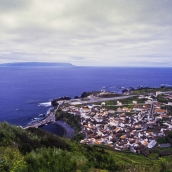Geography of Corvo
Corvo (17 km2) is the smallest island in the Azores. Along with Flores, it comprises the westernmost group of the archipelago, which is located over the North American tectonic plate, on the other side of the Mid-Atlantic ridge. Maximum altitude is 718 m (Morros dos Homes), quite considerable given the relationship between size and surface area, making it one of the highest islands in the Atlantic. The flattest part lies to the south, while the north sector houses a sizable volcanic edifice, the caldera de Caldeirão. Inside, two barely separated lakes measure 2 km in diameter and are broader north-to-south than east-to-west. Another three volcanic edifices lie to the south of this caldera, breaking the monotony of the landscape. The coastline is particularly rugged on the western side, where cliffs can exceed 400 m above sea level, the external walls of the caldera de Caldeirão being a fine example. The east coast has a more gently sloping profile and the lowest section is part of the southern platform, where Vila do Corvo, the capital and only urban centre, is located. This is an area of more recent volcanic filling, which contrasts with the towering cliffs along the rest of the coast.
Corvo is not usually affected by large earthquakes, since it lies outside the systems of transform faults associated with the Mid-Atlantic ridge. However, Atlantic cyclones occasionally leave their mark and the island can be cut off for several days.
Average annual rainfall is 1,055 mm and is highest in February and lowest in June, much the same as the rest of the archipelago. Rains are supposedly heavier the higher the altitude, but there is no specific information to confirm this phenomenon, although it has been demonstrated on other islands in the Azores. The sun index, as is the norm, increases from winter to summer, peaking in July and August, with an annual average of 1,622 days of sun. In contrast, cloud cover is frequent and widespread, a phenomenon that is mainly linked to the relief, location and northern latitude of the island. Cloud cover is highest between January and June, less pronounced between July and September, and slowly increases from October on. The average annual temperature is 17.6 °C, with maximums in August (22.7 °C) and minimums in February and March (14 °C). Corvo is frequently battered by strong westerly winds.













